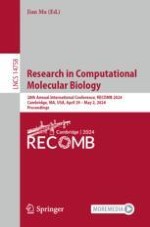2024 | Buch
Research in Computational Molecular Biology
28th Annual International Conference, RECOMB 2024, Cambridge, MA, USA, April 29–May 2, 2024, Proceedings
herausgegeben von: Jian Ma
Verlag: Springer Nature Switzerland
Buchreihe : Lecture Notes in Computer Science
